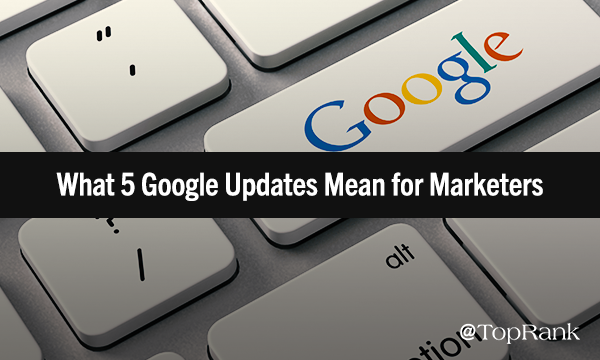Author: Anne Leuman / Source: Online Marketing Blog – TopRank®

Since the inception and rise of digital marketing, marketers have been keeping a watchful eye on Google — the ruler of the kingdom of search.
From research project to technology giant, over the last two decades Google has cemented itself as the dominating force in internet search. And while there are other rising contenders in the space, as of June 2018, Google owned 72.21% of all desktop searches. And the domination continues if you look at mobile, with Google owning a whopping 90.20% of searches.
Of course, Google’s market (and marketing) domination isn’t because of their speed to market in the late 90s, but rather the company’s dedication and investment in evolving the platform. And some of the latest evolutionary tweaks and new features are hitting soon — or have just recently arrived.
What are those changes and how will they affect your marketing plan? Below, we break down the latest and greatest game-changing updates from Google, what they mean for marketers, and how marketers can adapt.
#1 – HTTPS Warnings are In-Effect
While we’ve been talking about this for a while now (just see our Security as SEO post from August 2017), Google Chrome’s non-HTTPS pop-up warning went live in July 2018. Instead of serving non-HTTPS pages with just an information icon in the URL bar, Google will now serve users with a warning and potentially a pop-up alerting them that the website they’re on isn’t using a secure connection.

Of course, this shift towards site security isn’t new. In fact, back in January of 2016, Google announced that they were indexing HTTPS pages over HTTP pages, signaling to marketers that the security of your site will soon impact your rankings. The past algorithm changes coupled with the new warnings in Google Chrome means that leaving your site with an unsecure HTTP connection will likely cause traffic loss both organically and direct, as well as losing those hard-fought rankings.
To make sure that your site doesn’t take a hit to traffic or rankings, make sure you’ve upgraded to HTTPS. As an extra measure, check Google Search Console’s Security Issues tool to check for other potential security threats.

The Key Takeaways
- What’s New: HTTPS warning and pop-up goes live in Google Chrome.
- What It Means: Organic traffic and rankings loss if your site is non-HTTPS.
- Next Steps: Double check that your site is secure and upgrade to HTTPS if necessary.
#2 – Need for Speed
Over the last several years, Google has altered its algorithm to prioritize the user experience. Back in 2010, Google announced that desktop page speed was a ranking factor as poor load times create a bad user experience, which is something we covered in an interview with former Developer Programs Tech Lead Maile Ohye. Their latest update, which went into effect July 9, 2018, continues that trend as the algorithm will also account for mobile page speed as well.
But what pages are affected and how will it affect you?
According to Google, only the slowest pages will be affected. And to help you see if that includes you, they’ve launched their PageSpeed Insights tool where you can see how fast your pages load on mobile and how you can improve your load times.

With this new change, you need to make sure that your mobile page speed is up to par by entering your site URL into the PageSpeed Insights tool. Then, download your free report to see what improvements you can make to your site.
For example, the report may recommend that you optimize or compress your images to reduce the data consumption needed to load the page. Or, the report may suggest that you leverage caching. Whatever suggestions are made, implement them as soon as possible to ensure that your mobile rankings don’t suffer.
The Key Takeaways
- What’s New: Google now uses mobile page speed as a ranking factor for mobile searches.
- What It Means: If you’re mobile pages…
Peter Bordes Jr
Founder & Managing Partner Trajectory Ventures. Lifetime entrepreneur, CEO, Board Member, mentor, advisor and investor.
Obsessed with the infinite realm of possibility in disruptive innovation driving global digital transformation in technology, cloud-based infrastructure, artificial intelligence, data, DevOps, fintech, robotics, aerospace, blockchain and digital media and advertising.

